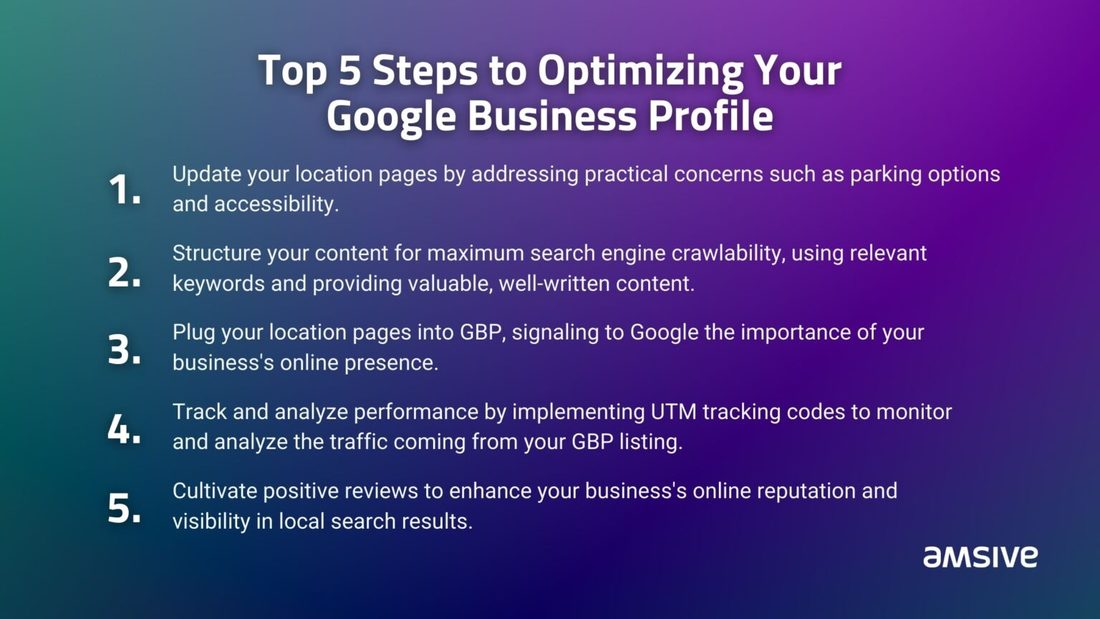
Think about the last time you googled ‘bank near me.’ When you did, what stood out to you about the Places section that appeared at the top of the results? Was there a franchised location that interested? Were you able to access a list of their services, or photos for the location you were interested in? Maybe you scrolled through the reviews to see if anyone had an opinion on the branch that caught your eye.
For multi-location businesses, optimizing your local SEO may seem like low-hanging fruit, but it’s an opportunity that businesses need to take full advantage of. A fully optimized Google Business Profile can help set expectations and drive new consumers to your site or any of your locations, regardless of the industry that you work in or with. Yet, despite the potential benefits, many businesses overlook the significance of optimizing their website and Google Business Profile, failing to leverage their full online visibility potential.
Updating your location pages and fine-tuning your Google Business Profile can help you reach your target audience, improve rankings, and increase your growth.
Creating and optimizing location pages for local SEO is more than listing basic information, like the business name, address, and phone number. By going beyond the essentials and providing valuable, detailed information, businesses can increase their visibility in local search results and attract more potential customers.
One crucial aspect of optimizing location pages for local SEO is structuring them in a way that makes them easy for search engines to crawl and understand. This can include using relevant keywords in the page titles, headings, and throughout the content. Use the information in your Google Business Profile to indicate what should be on your location pages. In other words, aim to make your GBP and location pages mirror one another.
Along with the standard business information, location pages should include details that are specific to the area, such as nearby landmarks, popular cross streets, or notable attractions. Providing this information not only helps customers find your business more easily but also alerts search engines to the fact that the page gives users relevant and truly helpful content.
Another important aspect to consider is addressing practical concerns that potential customers may have, such as parking options and accessibility. Including information about parking availability can be incredibly helpful for visitors. Providing details about public transportation options and mentioning if locations are wheelchair accessible can make the page more informative and useful.
Businesses can also enhance their location pages by mentioning nearby businesses or amenities that complement their own offerings. For example, a restaurant might highlight nearby attractions like theaters or museums, or a retail store could mention neighboring shops or popular shopping districts. Providing this context can paint a more comprehensive picture of the location and attract customers who may be interested in exploring the area.
Creating and optimizing location pages for local SEO requires a combination of strategic keyword use, hyper-local content, and user-focused information. By going beyond the basics and providing valuable content that speaks to the unique characteristics of the business’s location, businesses can drive consumers and boost local search result visibility.
Once you’ve created and optimized your location page, don’t let it go to waste — add it to your Google Business Profile.
By adding the URL of your location page to the website field of your GBP listing, you’re telling Google to pay closer attention to your business’s online presence. This can have a positive impact on your local search rankings, helping potential customers who are looking for your services in their area. Providing Google with a direct link to your location page through your GBP listing, you’re signaling to the search engine that your page has important information about your business and locations.
This is already a great update, but take it one step further. Adding a UTM tracking code to your GBP listing allows you to track and analyze the traffic that comes to your location page from your Google Business Profile. By adding a UTM to the URL of your GBP listing, you can track metrics such as the number of visits, as well as specific campaigns or promotions that may have led users to your location page. With this additional data, you can also identify areas for improvement and optimization.
While adding your location page to your Google Business Profile and including a UTM tracking code seems like a small step, it can help improve your local search rankings by providing valuable insights into your online performance.
There are a couple more areas for improvement on your Google Business Profile.
Besides the fact that it’s nice to be told that you’re doing a good job, reviews are crucial when you’re working on optimizing your local SEO. Google is placing increasing emphasis on customer feedback and customer experience, giving reviews an influential part to play in shaping perceptions and consumer decisions.
In the realm of local SEO, reviews are not a minor detail, but a strong factor that can impact a business’s visibility and ranking in search results. Google has underscored the importance of high-quality reviews, particularly those that are recent and accompanied by high star ratings. They’ve also gone so far as to weed out false reviews written by AI, ensuring that the positive feedback given to a business is genuine. Businesses that prioritize cultivating positive reviews and actively managing their online reputation can gain benefits in terms of search visibility and customer trust.
High-quality reviews have several beneficial impacts. In the context of local search, businesses competing for placement in the coveted local map pack— the display of three businesses shown at the top of local search results—often find that having a higher rating and a high number of recent reviews can be a factor in securing a spot.
Businesses should actively monitor and respond to reviews, both positive and negative. Engaging with reviewers shows transparency and a commitment to addressing customer feedback, which can improve trust and credibility. By responding promptly and professionally to reviews, businesses can potentially improve on negative experiences, as well as highlight the importance of customer’s experiences.
Another key field in your Google Business Profile is to add all the categories that apply to your business. This can significantly impact your local search rankings and ensure that your GBP is more likely to appear in relevant search results. Google lets you add up to 10 categories to your GBP listing, allowing businesses to more accurately represent their full range of products and services.
One strategy for selecting the right categories for your GBP listing is to look at what your competitors are using. By analyzing the categories listed in their GBPs, you can gain valuable insights into what your industry and target audience consider the most relevant.
For example, in the banking and financial services industry, it’s not uncommon for businesses to overlook key categories like “mortgage lender” or “business banking.” Failing to include these categories in your GBP listing when you offer them can significantly impact your local search rankings and visibility—especially if your competitors have their categories properly listed.
By accurately representing your business with relevant categories, you increase the likelihood of your GBP appearing in relevant search results and reaching the consumers whose searches align with your offers.
Optimizing your Google Business Profile is a strategic opportunity for businesses striving to increase visibility in today’s competitive digital landscape. From enhancing your location page to leveraging the power of customer reviews, each aspect of GBP optimization plays a crucial role in shaping your online presence and influencing customer perceptions. To harness the full potential of your GBP and drive tangible results for your business, remember the following actionable steps:

By taking these steps and consistently optimizing your GBP, you can set your business apart from competitors, attract more customers, and drive sustainable growth in today’s dynamic digital landscape.
Learn how to revolutionize your marketing strategy in 2024, or, let’s talk about achieving more for your marketing—and your business.
The original version of this page was published at: https://www.amsive.com/insights/seo/amplify-local-visibility-with-your-google-business-profile/
At Amsive our mission is to make data-centric marketing a reality for more than just the largest companies. As a full-service agency, we bring our clients’ marketing to life by shaping strategy, id... Read more
As technology and digital marketing continue to evolve at a rapid pace, so too must the guidelines that protect user privacy. Perhaps no industry needs to protect this right to privacy ...read more
If you are a local-dominant health plan or hospital system, this is for you! As a challenger brand, it’s not enough to just compete—you need to outsmart your competition. ...read more
Between market conditions, the Olympics, and the election, it’s no secret that advertising costs have been inching higher and higher over the last year. Digital ad spend in healthcare ...read more